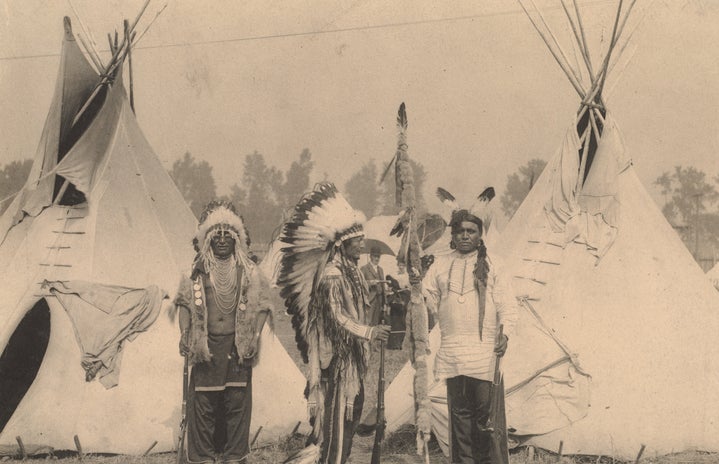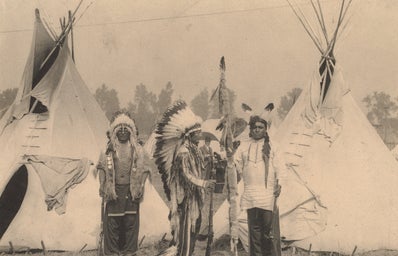In many standard high-school curriculums, most students don’t learn about Native American history after the 1900s. As a result, there’s the perpetual idea that Native Americans are simply part of an antiquated portion of American history. As a result, many of us did not learn about government-funded Native American boarding schools and their lasting impacts on the communities.
The first boarding schools appeared in 1869, but the true boom in Native American boarding schools began after Richard Henry Pratt executed his assimilation experiment.
The social experiment that jumpstarted it all
Using Apache prisoners of war, General Pratt taught them how to speak, read and write in English. He found that by fully assimilating them to white American culture by stripping them of their culture—cutting their hair, dressing them in uniforms and forcing them to speak English through strict military protocol—the Apache POWs learned white American culture. Pratt then took his findings to Congress and requested government funding to make this method of education mainstream, a process that would “kill the Indian, and save the man.”
Afterward, Pratt opened the first off-reservation boarding school, the Carlisle Indian Industrial School, in Carlisle, Pennsylvania, in 1879. Many describe it as “genocide disguised as education.” Numerous photographs of off-reservation boarding schools come from Carlisle where they were originally used as propaganda to promote Pratt’s method of assimilation. In many of them, he would use before and after photographs to document their progression to assimilation.
Kidnapping children for the sake of “education”
Because of the popularity and favorable opinions of Pratt’s experiments and assimilation projects, the push for Native American day schools and boarding schools intensified. In 1891, the U.S. government passed the Civilization Fund Act that made attendance at these schools compulsory for Native American children throughout the country.
As a common occurrence, armed police forcibly took these children from their tribes, bringing them to the schools often hundreds or thousands of miles away from their homeland. The U.S. government especially targeted children from recently hostile tribes, using them as hostages to force their tribes into pacification.
When parents and tribes refused to send their children to these schools, they faced harsh treatment from the U.S. government, including the withholding of food rations on reservations and incarceration. In 1894, 19 Hopi men in Arizona were incarcerated for opposition to sending their children to boarding schools. As a result, these men were imprisoned in Alcatraz for one year.
How these schools operated
Once the children arrived at the schools, school workers forcibly stripped them of every remnant of their Native American culture: they cut off their braids to give them identical haircuts, stripped them of their cultural clothing, bathed them in kerosene and gave them common white American names.
Furthermore, following Pratt’s assimilation model, these schools forced the Native American children to speak in English. In Carlisle, they rewarded children for not speaking their native languages. Additionally, many other boarding schools often punished children for speaking in their native tongue.
For classes, educational topics ranged from normal academic subjects like arithmetic and science to theology and religious training. However, to truly assimilate the children, boarding schools taught them the fundamentals of white American society: democracy. To fully prepare students for “civilized society,” they underwent citizenship training, where they learned about the principles of democratic institutions, structure and society.
Then to conform to heteronormative gender roles, girls learned to do housework like cooking, cleaning, sewing, laundry and caring for poultry. On the other hand, young boys learned trades like blacksmithing, shoemaking and other manual labor occupations.
What really happened in these schools?
Survivors of these schools still live to this day to tell the tales of the secrets that the boarding schools’ walls hid for decades. On the surface, they seemed like normal boarding schools where children resided. However, that’s far from the truth. From several accounts, mental, physical and sexual abuse was common. Furthermore, schools were often overcrowded and ran in unsanitary conditions, leading to disease running rampant. As a result, tuberculosis, trachoma, measles and smallpox were common illnesses that infected the halls.
Among these horrible conditions, children were frequently forced to do manual labor, faced neglect, starvation, confinement and even death. Suicide was a common occurrence throughout boarding schools. In several cases, for instance, in the Carlisle Indian Industrial School, the school had on-site cemeteries. Once a child passed away, his or her classmates were often the ones to build their coffins. For many parents of the deceased, they would not even know that their child passed until after their burial. Other times, many never learned about what happened to their child. Even when children did pass, they would rest in unmarked graves on school grounds. Many never returned to their homes even in death. Instead, they were confined to the grounds that had drained and tortured them in life.
The beginning of the end of the boarding school era
By the 1880s, 60 Native American boarding schools housed approximately 6,200 children. In the 1900s, 20,000 children attended these schools. Then by 1925, that number tripled to 60,000 children. In 1926, 83% of Native American school-age children lived in off-reservation boarding schools.
In the 1920s, exposure to the harsh conditions of the schools reached the public, bringing awareness to the abuse that ran throughout these institutions. Then by the 1960s, following the Civil Rights Movement, activists fought for the closure of these schools, and it wasn’t until the 1970s that more closures occurred.
By 1975, through the Indian Self-Determination and Education Assistance Act, the U.S. government gave Native American tribes the right to oversee and control the boarding schools. Today, there are four off-reservation boarding schools in Oklahoma, California, Oregon and South Dakota that Native American tribes run in partnership with the Bureau of Indian Affairs.
So, what now?
Similar schools have existed in other Western countries like Australia, New Zealand and Canada. Unlike the United States, the majority of these nations have apologized and given reparations to a degree for the creation of similar boarding schools for native populations. However, the United States has made little effort to apologize for the Native American boarding schools. The extent to which they have apologized included the 2009 Native American Apology Resolution, issued “to acknowledge a long history of official depredations and ill-conceived policies by the Federal Government regarding Indian tribes…” However, this apology has had little impact on federal policy regarding Native Americans. As of 2016, the U.S. Army is repatriating the remains of Native American children at Carlisle to their tribes and bands. However, because many of the buried children rest in unmarked graves, returning their bodies to their respective tribes has been difficult. This is still an ongoing effort, but it is the only known effort by the U.S. government to return these children to their rightful resting grounds.


